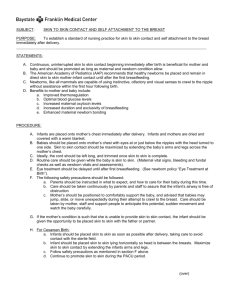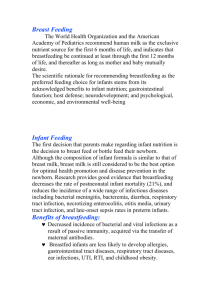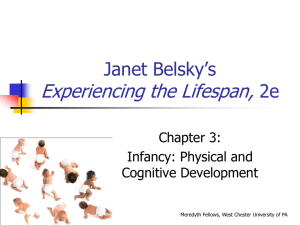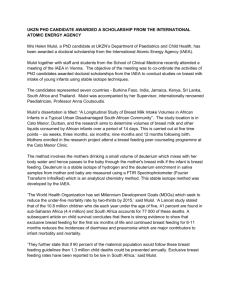Nutritional Needs of the Newborn
advertisement
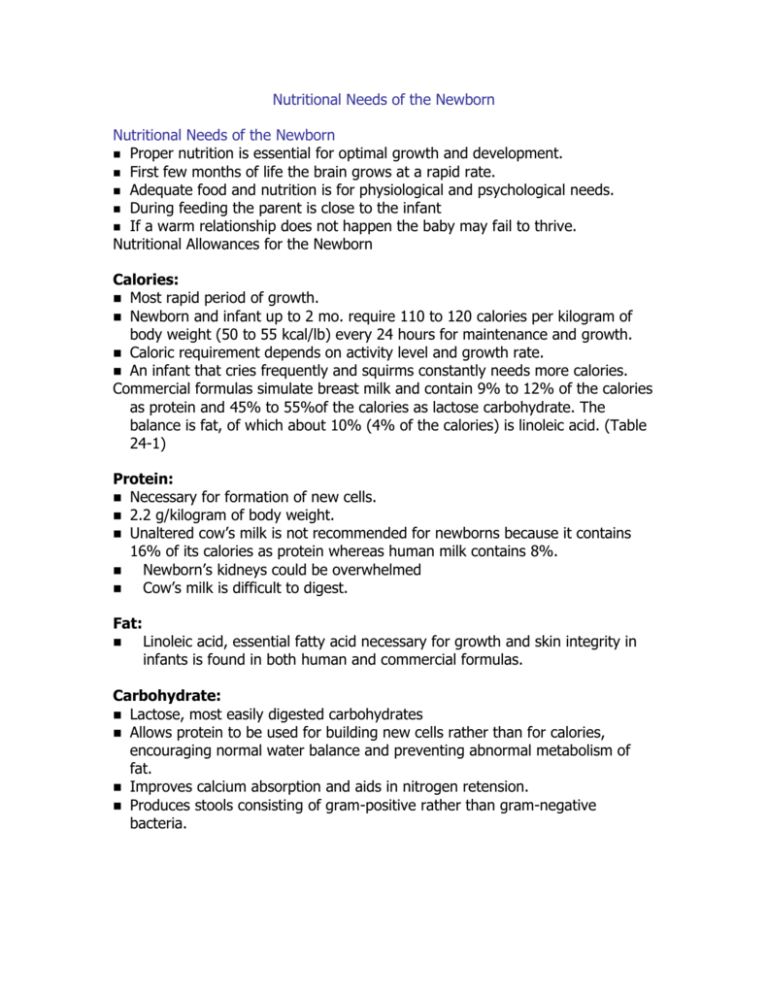
Nutritional Needs of the Newborn Nutritional Needs of the Newborn Proper nutrition is essential for optimal growth and development. First few months of life the brain grows at a rapid rate. Adequate food and nutrition is for physiological and psychological needs. During feeding the parent is close to the infant If a warm relationship does not happen the baby may fail to thrive. Nutritional Allowances for the Newborn Calories: Most rapid period of growth. Newborn and infant up to 2 mo. require 110 to 120 calories per kilogram of body weight (50 to 55 kcal/lb) every 24 hours for maintenance and growth. Caloric requirement depends on activity level and growth rate. An infant that cries frequently and squirms constantly needs more calories. Commercial formulas simulate breast milk and contain 9% to 12% of the calories as protein and 45% to 55%of the calories as lactose carbohydrate. The balance is fat, of which about 10% (4% of the calories) is linoleic acid. (Table 24-1) Protein: Necessary for formation of new cells. 2.2 g/kilogram of body weight. Unaltered cow’s milk is not recommended for newborns because it contains 16% of its calories as protein whereas human milk contains 8%. Newborn’s kidneys could be overwhelmed Cow’s milk is difficult to digest. Fat: Linoleic acid, essential fatty acid necessary for growth and skin integrity in infants is found in both human and commercial formulas. Carbohydrate: Lactose, most easily digested carbohydrates Allows protein to be used for building new cells rather than for calories, encouraging normal water balance and preventing abnormal metabolism of fat. Improves calcium absorption and aids in nitrogen retension. Produces stools consisting of gram-positive rather than gram-negative bacteria. Fluid: Metabolism rate is high. Newborns use 45 to 50kcal/kg. Requires a large amount of water. Body surface area is large in relation to body mass. Lose water by evaporation. Extracellular body wt. is 30 to 35% so lose depletes quickly. Kidneys are not fully concentrating urine so newborn cannot conserve body water easily Fluid requirement for newborn is 150 to 200 mL/kg per 24 hours. Supplied completely by breastfeeding or formula-feeding. Minerals Calcium: For bone growth. If newborn sucks well a low level seldom occurs. Iron: Term infants of a mother who had adequate iron intake during pregnancy will be born with iron stores lasting for 3 months, until newborn begins to produce hemoglobin. Most mothers do not get adequate iron in their diet a supplement is recommended for formula fed infants for 1 year. Breast fed has adequate supply. Fluoride: Essential for teeth. Teeth grow into their primary form during pregnancy. Mother needs to drink fluoridated water during and after pregnancy to supply the baby, also use in formula preparation. Fluoride supplement 0.25 mg/day may be given at 6 month of age. (can be detrimental or stain teeth) Vitamins Unnecessary for bottle fed infants because vitamins A,C, and D are in the formula. Vitamins are naturally in breast milk. May need exposed to sunlight for D or mother can take 400 U daily. Not given to infants until 6 months of age. Breastfeeding Preferred because it provides numerous health benefits to both mother and infant. Ideal nutritional source for infants for 1st yr. Nurses play a major role: Educating about benefits and management of breastfeeding. Help initiate breastfeeding within ½ hour of birth. Assist to breast fed and maintain lactation even if separated from the baby. Not giving newborns food or drink other than breast milk unless medically indicated. Not giving pacifiers to breastfeeding infants Practicing rooming in Encouraging breastfeeding on demand. Fostering the establishment of breastfeeding support groups and refer them when D/C. Physiology of Breast Milk Production Formed in acinar or alveolar cells of the mammary glands With delivery of placenta, progesterone level falls dramatically, stimulating the production of prolactin. (anterior pituitary) Prolactin stimulates production of milk. When infant sucks the breast this stimulates the hypothalamus to stimulate production of prolactin-releasing factor. Other hormones also contribute. Colostrum thin, watery, yellow fluid. Protein, sugar, fat, water, minerals, vitamins and maternal antibodies. Secreted by acinar breast cells starting in the 4th month of pregnancy. 1st 3 to 4 days after birth it continues. Easy to digest, high in protein, low sugar and fat. Transitional breast milk on 2nd to 4th day True or mature breast milk is produced by 10th day. Milk flows from alveolar cells where it is produced through small tubules to reservoirs for milk (lactiferous sinuses) behind the nipple. Foremilk-constantly forming milk. Let-down reflex- infant sucks, oxytocin is released from the posterior pituitary, causes collecting sinuses of mammary glands to contract, forcing milk forward through the nipples. May also be triggered by the sound of baby crying or thinking about the baby. Hind milk- new milk, formed after the let down reflex. Higher in fat than foremilk, makes the infant grow most rapidly. Oxytocin also causes smooth muscle to contract >uterus contracts> cramping in lower pelvis during first few days of breastfeeding. Advantages of Breastfeeding: Best for the baby. Decision depends on the mother. Contraindications: Galactosemia-infant cannot digest lactose. Herpies lesions on nipples. Mother on restricted-nutrient diet that prevents quality milk production. Mother on medications that are inappropriate for breastfeeding, (lithium) Mother exposed to radioactive compounds Breast cancer. Other situations. Advantages for Mother: Protective function for breast cancer. Release of oxytocin aids in uterine involution. Empowering effect. Reduces cost of feeding. True bonding. Myths: Contraceptive(ovulation returns in 4 weeks) Weight loss Advantages for the Baby: Immunoglobulin A(IgA) which binds with large molecules of foreign proteins including viruses and bacteria. Lactoferrin-iron-binding protein that interferes with growth of pathogenic bacteria. Lysozyme-destroys bacteria by dissolving cell membranes. Bifidus factor-growth promoting factor for lactobacillus bifidus, which interferes with colonization of bacteria in GI tract, reducing diarrhea. Ideal electrolyte and mineral composition. High lactose, easily digests sugar(rapid brain growth) Protein, nitrogen, linoleic acid. Less sodium, potassium, calcium and phosphorus than formula. Spare work on kidneys. Allergies Better dental arch. Disadvantage: May carry microorganisms-hep B, cytomegalovirus, HIV, illicit and prescription drugs, environmental contaminants via breast milk. Preparing for Breastfeeding: Ask during pregnancy. Physical preparation- breast massage to make milk move forward, manual expression of milk, and cleansing (no soap). May need nipple cup. Beginning Breastfeeding: As soon after birth as possible. Infant opens mouth wide enough to grasp nipple and areola when sucking. Ensure that breast is completely empty at every other feeding. Milk forms in response to being used. If completely emptied it will fill completely, if ½ emptied then it will fill ½ and milk production will be insufficient. Should not offer bottles until 6 wks of age. Prolonged Jaundice in Breastfed Infants: Caused by (pregnanediol) a breakdown product of progesterone in breast milk depresses action of glucuronyl transferase, the enzyme that converts indirect bilirubin to direct form, which is excreted in bile. Woman should feed frequently in immediate birth period because colostrum is a natural laxative and helps pass meconium and bile. Pregnanediol remains 24 to 48 hours. Provide information on lactation and positioning: Appearance of milk. Wash hands (nipple if caked) Lie on side, use pillows. Rooting reflex Infant breathing not obstructed. Feed as often as hungry - 2 to 3 hours. Help brake away from breast. Keep baby awake. Massage breasts to empty. Give support and positive reinforcement. Burping after 1st breast is emptied and after done feeding. ( Engorgement – vascular and lymphatic congestion arising from increased in blood and lymph supply to the breast. Breast distention, swelling, hardness, tenderness, heat, areola too hard for baby to grasp. Prevent or relieve engorgement: Have baby suck more often to empty breast. Warm packs for 20 minutes. Good bra for support of breast. Stand under shower and massage softens breast so infant can suck. Breast pump after feeding to complete emptying of the breast. Transient/temporary problem (lasts 24 hrs.), mother fears infection. Sore Nipples: Soreness from strong sucking action of infant. Improper positioning of infant. Forcefully pulling infant from breast. Sucking too long after breast is emptied. Permitting nipple to remain wet from leaking milk. Excessive dryness can cause cracking or fissure. Avoid plastic bra liners. Prevent soreness by: Position baby slightly differently for each feeding to avoid pressure on the same area of the aerola. Expose nipples to air for 10 to 15 min. after feeding. Apply vitamin E after air exposure may toughen and prevent further irritation. Avoid hand pump. Do manually. common problems of breast feeding. Mother needs to drink at least 4 8 oz. glasses of fluid a day. Increase caloric intake by 500 calories, (table 24.4 p. 685 and table 24.5 p. 686) Breast milk refrigerated for 24 hours, frozen for 30 days, or deep freeze for 6 months. Mother that works outside home: Express breast milk. Weaning: Breast feed for 1,2,3 months then use bottle. May breast feed for 6 to 12 months and wean to small cup. Some continue….. May lead to nutritional deficiencies. Discontinue gradually to avoid engorgement and pain. If weaned before 12 months use formula not whole milk. Formula Feeding May have developed a breast abscess, other conditions that stop breast feeding. Preparing for Formula-Feeding: Allergic to protein in formulas > diarrhea and vomiting > anemia. May need switched to a prescribed formula. Commercial Formulas: Supervised by FDA 3 types: Milk based, soy based and elemental. Milk based used for average newborn. Lactose free formula for infants with lactose intolerance or galactosemia. Soy for infants allergic to cow’s milk protein. All the above are designed to simulate the nutritional content of breast milk and contain supplemental vitamins.(get added iron type) Elemental is used for infants with protein allergies and fat malnutrition. For term newborns formulas contain 20 cal/oz when diluted according to directions. Use for 1 year. Forms of commercial formulas: Powder combine with water.(less cost) Condensed liquid diluted with equal amount of water. Ready to pour. Individually prepackaged and prepared bottles of formula.(most cost) Calculation of Formula’s Adequacy: Total fluid ingested for 24 hours must be sufficient to meet needs; 75 to 90 mL (2.5 to 3 oz) of fluid per pound of body weight per day (150 to 200 mL/kg) is needed. Number of calories required per day is 50 to 55 per pound of body weight (100 to 120 kcal/kg). Add 2 or 3 to infants age in months. Supplies: Glass, plastic or disposable refill bottles. Keep opened formulas covered and in refrigerator, discard with in 24 hours. Firm nipples. Preparation: Wash top of can with warm soapy water and rinse. Pour into clean bottles. Apply nipple do not touch the nipple. Place bottle cap over nipples and refrigerate. Teach feeding techniques: Microwave will heat formula in center hotter than the side. Shake and test on wrist. Do not store and reuse formula. Comfortable position. ½ hour to feed. Head of baby elevated. Avoid intake of air. Early weeks bubble after every oz. Do not prop bottles. Discharge Planning: Teach and answer questions. 6 to 8 diapers/day 10 min on each breast. Sleep Home care referral. Telephone number to call. Appointments.
